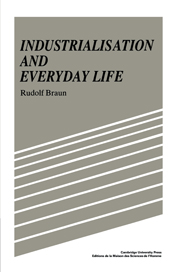Book contents
- Frontmatter
- Contents
- Prefaces
- Acknowledgements
- Note on measures and coinage
- Introduction
- 1 The preconditions for industrialisation
- 2 Changes to the structure of family and population in the industrial regions
- 3 Life and society of the population engaged in industry
- 4 The impact of industrialisation on the house and the rural economy
- 5 Work in the putting-out industry and its effect on the life of the common people
- 6 The outworkers' attitude to poverty and crises
- 7 Conclusion
- Postscript
- Appendix: a note on the administrative structure and social stratification in the countryside of Zurich during the Ancien Régime
- Notes
- Sources and bibliography
- Index
3 - Life and society of the population engaged in industry
Published online by Cambridge University Press: 16 March 2010
- Frontmatter
- Contents
- Prefaces
- Acknowledgements
- Note on measures and coinage
- Introduction
- 1 The preconditions for industrialisation
- 2 Changes to the structure of family and population in the industrial regions
- 3 Life and society of the population engaged in industry
- 4 The impact of industrialisation on the house and the rural economy
- 5 Work in the putting-out industry and its effect on the life of the common people
- 6 The outworkers' attitude to poverty and crises
- 7 Conclusion
- Postscript
- Appendix: a note on the administrative structure and social stratification in the countryside of Zurich during the Ancien Régime
- Notes
- Sources and bibliography
- Index
Summary
The remarkable population increase which occurred in the eighteenth century in the industrial regions of the Zurich territory had unavoidable consequences for the life of all the common people. This demographic surge was felt in all spheres of everyday life and society. The movement had some of the frenzied power of a natural phenomenon. We have heard the voices of those who were horrified by this phenomenon and it is understandable that such voices became more frequent in times of hardship and crises. But in many places there also arose, alongside the horror, concern and the desire to understand the origins of the population growth, to identify its manifold effects and by so doing also to accept its trail-blazing innovations. Johann Conrad Niischeler summed up this patriarchal awareness of responsibility in a chapter-heading in his Beobachtungen eines redlichen Schweizers (Observations of an Honest Swiss) (1786): ‘The population increase, which it is imperative to know and learn about beforehand’.
There was no shortage of minds capable of recognising the extent to which industrialisation built up pressure within the closed sphere of a legal and economic order, within the rigid constraints of the social structure and the dogmatic stranglehold of the ecclesiastical authorities' moral legislation; but the Helvetic Revolution (1798) had to occur before the pressure could be released. J.C. Hirzel spoke in 1792 of ‘the belt which the authorites were obliged to loosen’. In the event, to extend Hirzel's metaphor, the citizens/subjects had long ago grown out of the clothes offered them by the authorities. The following example is intended to introduce us to this chapter's line of enquiry.
- Type
- Chapter
- Information
- Industrialisation and Everyday Life , pp. 61 - 110Publisher: Cambridge University PressPrint publication year: 1990

